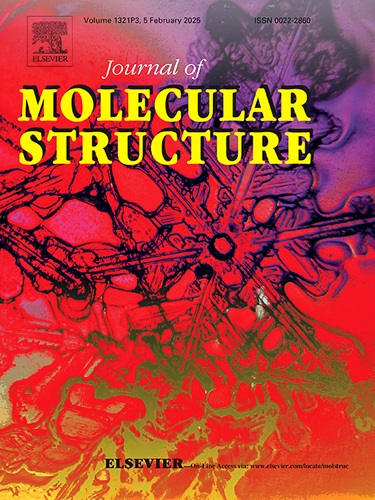Synthesis, characterization and corrosion inhibition of 1-(4-anisyl)-3-(4-(pyridin-4-ylmethyl)phenyl)carbamide on mild steel in 1M HCl: A comprehensive study from experimental, theoretical and microscopic modelling perspectives
IF 4
2区 化学
Q2 CHEMISTRY, PHYSICAL
引用次数: 0
Abstract
In the present study, a novel, cost-effective organic corrosion inhibitor, 1-(4-anisyl)-3-(4-(pyridin-4-ylmethyl)phenyl)carbamide (U–OCH3), was synthesized and characterized by spectroscopic techniques. The corrosion inhibition properties of U–OCH3 against mild steel (MS) in 1 M HCl medium were evaluated through weight loss measurements, electrochemical tests, surface analysis, and theoretical calculations. The experimental results demonstrated that 200 ppm of U–OCH3 exhibits excellent corrosion inhibition, with a high inhibition efficiency of 98.62 % at 303 K, though its effectiveness decreases with increasing temperature. Kinetic and thermodynamic analyses suggested that U–OCH3 inhibits corrosion through physisorption, with a mixed-type inhibitive action that adheres to Langmuir's adsorption isotherm. Surface analysis using Scanning Electron Microscopy (SEM), Energy Dispersive X-ray Analysis (EDX), Atomic Force Microscopy (AFM), and X-ray Photoelectron Spectroscopy (XPS) confirmed the formation of a thin inhibitor film, which adsorbs onto the steel surface via interactions with the heteroatoms (pyridine and phenyl rings) in U–OCH3. Density Functional Theory (DFT) calculations revealed a strong correlation between the inhibitor's molecular structure and efficacy. Fukui index analysis identified specific attack sites on the metal surface. At the same time, Molecular Dynamics Simulations (MDS) provided insights into the interaction energies between the inhibitor and the steel surface, further validated by Radial Distribution Function (RDF) measurements. The study also assessed the self-diffusion coefficient, fractional free volume (FFV), and interactions between the inhibitor film and corrosive species, with experimental results aligning closely with theoretical predictions.

求助全文
约1分钟内获得全文
求助全文
来源期刊

Journal of Molecular Structure
化学-物理化学
CiteScore
7.10
自引率
15.80%
发文量
2384
审稿时长
45 days
期刊介绍:
The Journal of Molecular Structure is dedicated to the publication of full-length articles and review papers, providing important new structural information on all types of chemical species including:
• Stable and unstable molecules in all types of environments (vapour, molecular beam, liquid, solution, liquid crystal, solid state, matrix-isolated, surface-absorbed etc.)
• Chemical intermediates
• Molecules in excited states
• Biological molecules
• Polymers.
The methods used may include any combination of spectroscopic and non-spectroscopic techniques, for example:
• Infrared spectroscopy (mid, far, near)
• Raman spectroscopy and non-linear Raman methods (CARS, etc.)
• Electronic absorption spectroscopy
• Optical rotatory dispersion and circular dichroism
• Fluorescence and phosphorescence techniques
• Electron spectroscopies (PES, XPS), EXAFS, etc.
• Microwave spectroscopy
• Electron diffraction
• NMR and ESR spectroscopies
• Mössbauer spectroscopy
• X-ray crystallography
• Charge Density Analyses
• Computational Studies (supplementing experimental methods)
We encourage publications combining theoretical and experimental approaches. The structural insights gained by the studies should be correlated with the properties, activity and/ or reactivity of the molecule under investigation and the relevance of this molecule and its implications should be discussed.
 求助内容:
求助内容: 应助结果提醒方式:
应助结果提醒方式:


